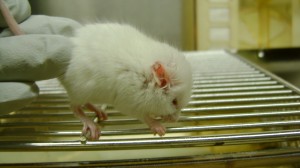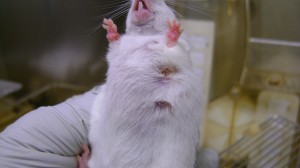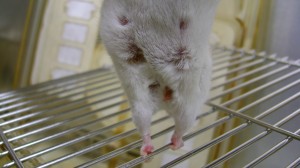EXPENSES IN SCIENTIFIC RESEARCH WITH ANIMAL MODELS
- cost of animals
- food and water
- bedding
- cage processing and changing
- animal care technician time
- experimental materials and apparatus
- salary of institutional researcher
- salary of veterinarians
- miscellaneous administrative fees accumulates daily
A) The Danger of Viewing Animals as Resources and Products:
Case Study:
- Principle investigators’ mice are charged $1 a cage per day
- Facilty’s own colonies (C57/6J and CD1 mice, Wistar and Sprague-Dawley rats): profited only from internal or external research laboratories orders and purchase
- Problem: Demands for research mice and rats varies in number and age depending on grant availability and protocol needs, therefore difficult to maintain an optimal number of purchasable colony animals
- Result: Excess, old, and/or phenotypically undesirable were culled monthly for economic conservation and spatial liberation
- Monthly: 30% of the animals (approximately 450 cages, each with an average of 3 animals; 3*450 = 1350 animals each month) are regularly disposed of, with new breeders set up to replace them
Things got worse…
- In October 2011, the facility is $1 million in deficit
- Can no longer afford to keep all colonies
- First: 30 cages of Wistar rats taken off inventory
- Second: 200 of out 300 cages of CD1 mice disposed of
- Last but not least: Elimination of 300 cages of Sprague-Dolly rats
Improvement:
- Great room for improvement on research facility’s financial management, and the need to balance cost and benefits research animals as products
B) Expensive Transgenic Mice
- Cost of procedure (injecting desired modified genes into several mice embryos to create one genotypically correct mouse): $4000 to $5200 USD
- Consequences of high price: Researcher want to maximize the use of each animal and set later endpoints, which could conflict with the interest of animal welfare.
- E.g. Principle investigator was so keen on saving a litter of pups that could contribute greatly to their studies that he/she instructed the technicians to keep the conspicuously deteriorating diabetic breeder female until weaning date
Improvement:
- Transgenic procedures should become more widespread and less expensive through training more competent technicians and research assistants to perform these techniques
C) Costs to Improve Welfare:
- CCAC’s euthanasia guidelines: suggests that initial induction of the animal with inhalant anesthetics is likely more humane than euthanasia with just carbon dioxide
- Problem: Rodent anesthesia system costs more than $2000 USD
Improvement:
- CCAC could consider financially subsidizing for purchase of apparatus needed for improved animal welfare at each research institute.



